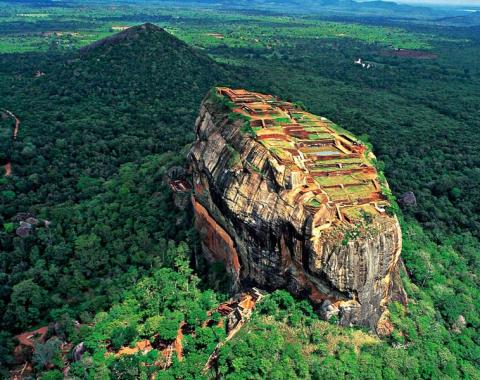Detailed Itinerary
Day 01 to Day 02
Day 1 - Arrival - Negombo
SCHEDULE
-
On arrival at the Bandaranaike International Airport, meet and greet & transfer to Negombo
-
Check in to the hotel (check in time after 12. 30 p.m)
-
Evening - enjoy a short visit to the neighbouring communities with your guide (Depending on your arrival time)
-
Dinner and overnight stay at your hotel in Negombo
Less than 5 kilometres from the airport is the fishing coastal city of NEGOMBO. Captured by colonisers starting in the 17th century, it's priceless cinnamon trees was a gold mine for the likes of the Dutch, Portuguese and the British. Today, regal churches and colonial styled buildings reflect a bygone era, amidst the hustle and bustle of a vibrant fishing city, blessed by a beautiful lagoon and canals to explore the place and of course the beach - warmly embraced by the Indian Ocean.
Day 2 - Negombo – Dambulla – Sigiriya
SCHEDULE
-
Early morning visit to an authentic fish market in Negombo and interaction with a vibrant and busy fishing community
-
Leave for Sigiriya via Dambulla after breakfast
-
Visit Dambulla Cave Temple
-
Check in for an overnight stay at the hotel in Sigiriya
Dambulla Rock Cave Temple, known as the “Golden Temple” consists of 5 caves, containing countless images of Buddha and goes back to 1st century BC when King Valagambahu took refuge here. The most elaborate and most spectacular of the five, is the second cave – which at 170 feet in length 75 feet in width and 21 feet high, is the largest of all. There is a large reclining Buddha statue and statues of two kings namely, Valagambahu who took first took refuge there and did most of the constructions and Nissankamalla who later improved on the cave. In the centre of this cave, is a large container to collect the water that drips from the rock ceiling even during the dry season. This place is worth visiting not only for the cave temple, but also for the beautiful view over the countryside one gets from near the caves situated at around 150m above the road.
Day 03 to Day 04
Day 3 - Sigiriya – Polonnaruwa – Sigiriya
SCHEDULE
-
Breakfast at the hotel
-
Climb Sigiriya Rock Fortress after breakfast
-
Upon finishing the visit at Sigiriya proceed to Polonnaruwa
-
Visit Polonnaruwa Historical Site
-
Back to the hotel in Sigiriya for overnight stay
The ancient city of SIGIRIYA is a signature historical destination in Sri Lanka. A World Heritage Site since 1982, it shares the stage with the monumental wonders of the Pyramids and the Grand Canyon, and is even considered as the Eighth Wonder of the World. The Rock gets its name from the words ‘sinha’ (lion in Sinhala) and ‘giriya’ (throat), hence the word: Sigiriya. The iconic paintings of the ‘Cloud Maidens’ have been paid tribute to by poets over the ages. The frescoes exude a beauty and artistry only comparable to the Ajanta frescoes of India. The final and almost precarious ascent to the top of the Rock, is through – what remains of a majestic lion sculpture: the gigantic paws, sculpted into the side of the rock. And on reaching the summit one stands tall, 600 feet from the ground, with a breathtaking panoramic 360 degrees view with gusts of wind which can catch you unawares.
POLONNARUWA has historically been a favoured capital city in ancient Lanka. King Vijaya Bahu was the first to make the city his capital but it is during King Parakrama Bahu’s rule, that the city experienced a renaissance. The planned development of the city saw intense activity in irrigation systems, strengthening of trade and special emphasis on sculpture, art and architecture. The 2500 hectare tank called 'Parakrama Samudra' (Sea of Parakrama) is a scenic reservoir draped with greenery and brushed with sweeping, cool winds. Walk around the historic sites and be a guest at the ruins of the Audience Hall and ‘Nissanka Malla’, the Royal Palace, all impressive structures, reflecting the grandeur of that civilisation. Interestingly, one will see the emergence of South Indian architecture along with Dravidian and Hindu artistry – a facet never seen before this era. The Shiva temple, made entirely out of stone, captures Chola temple architecture taking its place prominently - along with other forms of art and sculpture - in Polonnaruwa.
Day 4 - Sigiriya – Kandy
SCHEDULE
-
Breakfast at the hotel
-
Leave for Kandy after breakfast
-
Visit Aluvihare Temple in Matale
-
Check in at the hotel in Kandy
-
City tour in Kandy in the evening, including a visit to Temple of Sacred Tooth Relic & a Cultural Show
-
Overnight stay at the hotel in Kandy
The Aluvihare Temple was built by King Devanampiyatissa around the 3rd century BC. Situated in Matale, about 30 kilometres from Kandy, it is enclosed by hills and rocks. It is widely accepted that this temple has a historical importance in the reservation of Buddhism in Sri Lanka as it is here that the writing of the Tripitaka (Buddhist scriptures) in Pali happened after the passing away of Lord Buddha. The preservation of his teachings was passed on verbally.
Sri Dalada Maligawa, the Temple of the Tooth, dates back to the 16th century, with many extensions and changes occurring until the 19th century. It is home to the Sacred Relic of the Tooth of Buddha – the most venerated object in the Buddhist world. Walking into the shrine will take one through numerous buildings, corridors and chambers that are highly decorated with colourful and ornate carvings. Various services are held daily for the worshippers. The distinct sounds of traditional drums skillfully handled by costumed artistes, accentuate the spiritual ambience. The drums also signal the ceremonial opening of the Inner Chamber’s window for the public viewing of the casket with the Relic - brought from India 2500 years ago. The tour does end prior to the commencement of the drumming.
Day 05 to Day 07
Day 5 - Kandy
SCHEDULE
-
After a laidback breakfast, a visit to Gadaladeniya & Lankathilaka, in the suburbs of Kandy
-
A luncheon with a French turned Sri Lankan historian to discuss Sri Lankan history, culture and art
-
Return to the hotel
-
In the evening you will be met by our special invitee, to attend a brief Buddhist ritual. This will be followed by a 45 minute discussion about Buddhism & meditation
-
Overnight stay at the hotel in Kandy
Gadaladeniya Rajamaha Viharaya is an ancient monastery located on a hilltop in Diggala. An inscription there proclaims that it was built by King Buwanekabahu IV in the year 1344. The main shrine houses a seated Buddha surrounded by four standing Buddha statues. While the frescoes and interior sculptures found here depict Jataka stories of Lord Buddha. A distinct feature of the shrine is the Makara Thorana (Dragon Arch) which is embellished with images of gods like Brahma, Sathusta, Suyama and Natha. Noteworthy is the strong influence of South Indian architecture alongside Kandyan artistry.
Overlooking the Hantane mountain range, the Lankathilaka Viharaya was constructed entirely on rock and using granite for its main building. Beautiful murals and decorative paintings, especially of two lions, adorn the monastery.
Professor Jacques Soulie
Professor Jacques Soulie, the Director of the Alliance Francaise (French Cultural Centre) Kandy, has made this city his home. He has mastered speaking the Sinhala language and has become pivotal in strengthening Franco-Sri Lankan relations. In addition, he is a visiting lecturer at the Peradeniya University and contributes to literary events.
Vipula Wanigasekera
A Senior lecturer at the National School of Business Management and a Marketing Professional, Wanigasekera, has many years of experience in meditation. His collective experiences motivated him to write the book ‘Pointers to Enlightenment’ paving the way for Wanigasekera to conduct meditation sessions.
Day 6 - Kandy – Colombo
SCHEDULE
-
Breakfast at the hotel
-
Following breakfast, depart for Colombo
-
Check in at the hotel
-
Evening City tour in Colombo in the evening
-
Overnight stay at the hotel in Colombo
COLOMBO is Sri Lanka’s stand out city and hub for anything new. Amidst the impressive hotels and high rise buildings, the past peeps through, if one takes a closer look. Arab traders docked at this strategic city to trade in spices and gems. The Portuguese, Dutch and the British all used Colombo as a central command location. Street names such as Bloemendhal Road, De Kretzer Road and Gregory’s Road are all reminiscent of a bygone time. Many colonial buildings can be also seen around the city. Independence Square with its landscaped gardens is a monumental salute to Sri Lanka’s Independence; an emblematic structure of grand Sri Lankan architecture; an inheritance of centuries’ worth.
Day 7- Colombo – Departure
-
After breakfast depart for the Airport (check out time from the hotel is before noon)
[Please check-in at least 60 minutes before the scheduled time of departure]

















